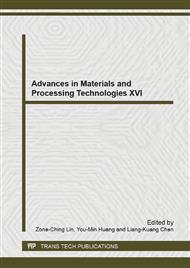p.623
p.630
p.635
p.647
p.655
p.663
p.671
p.679
p.684
The Nanostructure Fabrication on Conductive Diamond-like Carbon Thin Film by Nano-Oxidation Technique
Abstract:
This paper mainly focuses in the use of an atomic force microscope, research about the nanooxidation technique of conductive diamond-like carbon thin film in the atmospheric environment. The hardness, high wear resistance and chemical stability of diamond-like carbon thin film is high, and coefficient of friction is low, it is very suitable as a mold material for nanoscale mold. However, tool can only use a diamond cutter to machine the high hardness diamond-like carbon by traditional hard machining method, and tool life is not long. To overcome this drawback, the paper proposed an atomic force microscope (AFM) as a platform, a conductive AFM probe for tool under atmospheric conditions, and imposed nanooxidation technique on conductive diamond-like carbon thin film using electroluminescent etching to carry out nanofabrication processing. During the nanofabrication process, by changing the various processing parameters, such as applied voltage, repeated nanooxidation times and probe speed, etc., in order to understand the effect of processing parameters. The experimental results show, the nanooxidation technique can be carried out nanofabrication on conductive diamond-like carbon thin film successfully. And found that applied voltage, repeated nanooxidation times and probe speed all for the groove depth on the conductive diamond-like carbon thin films have significant influence. Additionally, this study successfully created a nanopattern. Therefore, the adequate machinability of DLC coating was achieved successfully in this study, indicating a promising application in the fabrication of nanopatterns on a nanoscale.
Info:
Periodical:
Pages:
671-678
Citation:
Online since:
May 2014
Authors:
Price:
Сopyright:
© 2014 Trans Tech Publications Ltd. All Rights Reserved
Share:
Citation:


